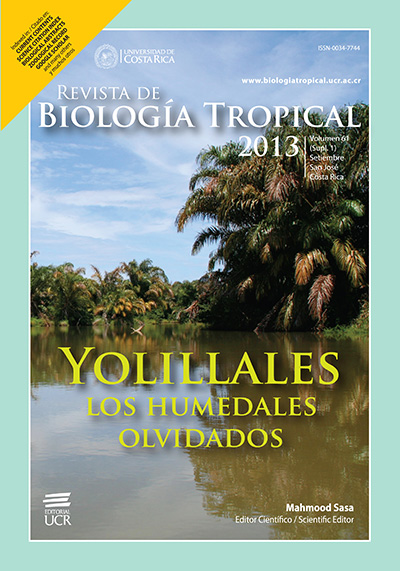Abstract
In the Tortuguero floodplains, Costa Rica, a significant number of trees such as Carapa guianensis, Pentaclethra macroloba and the palm Manicaria saccifera have floating seeds adapted to hydrocory, while others, such as the almendro Dipteryx oleifera and the raffia palm Raphia taedigera have heavy seeds that do not float. These species have differential distributions, and while C. guianensis, P. macroloba and D. oleifera also grow on slopes away from the flood, the palms M. saccifera and R. taedigera hardly occur outside the swamps, where they stand as the dominant species. To understand the differences in the micro-distribution of these tree species in waterlogged environments and differences in their seed adaptations, I did a series of experiments to compare the loss and germination of their seeds in the slope forest and in palm swamps in the region. Overall, seeds in the forest slope have higher removal rates than those in the M. saccifera and R. taedigera swamps. This last one exhibits the lowest seed loss of all three habitats. Also, differences in seed predation/removal were noticed between the two species of palms studied. Thus, seeds of M. saccifera disappeared rapidly, regardless of density aggregation and location in the swamp. Removal rates in R. taedigera seeds were low in the raffia dominated swamp, where apparently, seed losses are slightly higher in the mounds of palm clumps than in the swamp floor. These observations suggest that both: flooding and microtopography determine, directly or indirectly, the fate of tree species within these wetlands. Restrictions on seed dispersal and the slow germination confine R. taedigera marshes and flooded places, whereas flooding and predators mediate in the distribution of the other tree species.
References
Bodmer, R.E. 1991. Strategies of seed dispersal and seed predation in Amazonian ungulates. Biotropica 23: 255-261.
Braun, A. 1968. Cultivated palms of Venezuela. Principes 12: 39-103.
Chun, J., C.L. Goodman, W.C. Rice, A.H. McIntosh, M.G. Chippendale & K.R. Schubert. 1994. Pentaclethra macroloba seed effect on larval growth, cell viability, and midgut enzyme activity of Helicoverpa zea (Lepidoptera: Noctuidae). J. Econ. Ent. 87: 1754-1760.
Gottsberger, G. 1978. Seed dispersal by fish in the inundated regions of Humaita, Amazonia. Biotropica 10: 170-183.
Goulding, M. 1980. Fishes and forest. University of California, Berkeley, California, EE.UU.
Grime, J.P. 1979. Plant strategies and vegetation processes. Wiley, Nueva York, EE.UU.
Hartshorn, G.S. 1972. The ecological life history and population dynamics of Pentaclethra macroloba, a tropical wet forest dominant, and Stryphnodendron excelsum, an occasional associate. Ph.D. thesis, University of Washington, Seattle, Washington, EE.UU.
Hartshorn, G.S. 1978. Tree falls and tropical forest dynamics, p. 617-638. In P.B. Tomlinson & M.H. Zimmermann (eds.). Tropical tress as living Systems. Cambridge University, Nueva York, EE.UU.
Holdridge, L.R. 1963. El Real environmental survey, Darien Province, Republic of Panamá. U. S. Army Transp. Research Command, Washington, Columbia, EE.UU.
Holdridge, L.R., W.C. Grenk, W.H. Hatheway, T. Liang & J.A. Tosi Jr. 1971. Forest environments in tropical life zones: a pilot study. Pergamon, Oxford, Inglaterra.
Horn, M.H. Evidence for dispersal of fig seeds by the fruit-eating characid fish Brycon guatemalensis Reagan in a Costa Rican rainforest. Oecologia 109: 259-264.
Janzen, D.H. 1974. Tropical blackwater rivers, animals, and mast fruiting by the Dipterocarpaceae. Biotropica 6: 69-103.
Janzen, D.H. 1978. Seeding Patterns of tropical trees, p. 83-128. In P.B. Tomlinson & M.H. Zimmermann (eds.). Tropical trees as living systems. Cambridge University, Nueva York, EE.UU.
Kubitzki, K. & A. Ziburski. 1994. Seed dispersal in flood plain forests of Amazonia. Biotropica 26: 30-43.
Morris, D. 1962. The behavior of the green acouchi (Myoprocta pratti ) with special reference to scatterhoarting. Zool. Soc. Lond. Proc. 139: 701-732.
Myers, R.L. 1990. Palm swamps, p. 267-286. In A.E. Lugo, M. Brinson & S. Brown (eds.). Forested wetlands. Elsevier Science, Amsterdam, Holanda.
Myers, R.L. 2012a. Fenología y crecimiento de Raphia taedigera (Arecaceae) en humedales del noreste de Costa Rica. Rev. Biol. Trop. 61 (Supl. 1): 35-45.
Myers, R.L. 2012b. Germinación de semillas y supervivencia de plántulas en pantanos dominados por yolillo Raphia taedigera (Arecaceae) en las Llanuras de Tortuguero, Costa Rica. Rev. Biol. Trop. 61 (Supl. 1): 47-66.
Ng, F.S.P. 1978. Strategies of establishment in Malayan forest trees, p. 129-162. In P.B. Tomlinson & M.H. Zimmermann (eds.). Tropical trees as living systems. University of Cambridge, Nueva York, EE.UU.
Oppenheimer, J.R. 1968. Behavior and ecology of the white-faced monkey, Cebus capucinus on Barro Colorado Island, Canal Zone. Ph.D. thesis, University of Illinois, Urbana, Illinois, EE.UU.
Symthe, N. 1970. Relationships between fruiting seasons and seed dispersal methods in a neotropical forest. Am. Nat. 104: 25-35.
Comments

This work is licensed under a Creative Commons Attribution 4.0 International License.
Copyright (c) 2013 Revista de Biología Tropical






